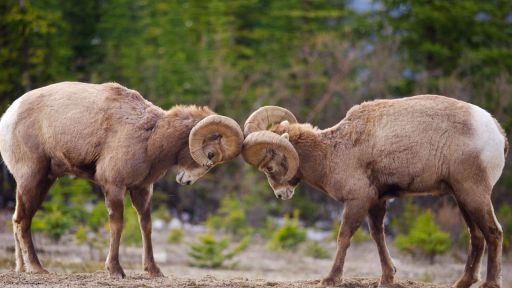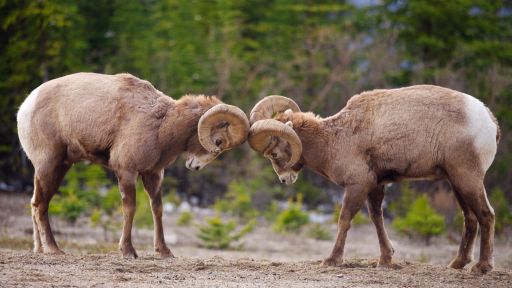In the latest of our conservation short film series, uncover the frightening truth about a pervasive epidemic that threatens one of North America’s most iconic animals – the bighorn sheep.
Running With The Herd: A NATURE Short Film
Biologist Jack Hogg has been studying a herd of wild bighorn sheep on Montana’s National Bison Range for more than 35 years. When Jack’s herd gets infected with a deadly form of pneumonia, he goes in search of answers.
Features



As humans, we're always seeking that one trait that sets us apart from every other animal.
You know what makes us special. Maybe there's nothing. If we really could step into the mental life of all other animals, we would find precedence for almost everything that we've claimed to be special.
It's not something that I planned on doing. I mean I didn't anticipate being here 35 years later. [Narrator:] For more than 35 years, biologist Jack Hogg has been studying a herd of over 200 Rocky Mountain bighorn sheep on Montana's National Bison Range. 'It's an extraordinary experience really. I mean it's a chance to share in the alien society.' 'The animals are habituated but they're not tame and so it's really quite extraordinary to be able to see an animal that really is wild. You don't have to stalk them. You know you basically just walk out and sit down and they ignore you and you get to observe their lives.' [Narrator:] Jack knows every member of the herd by sight and every individual has a name and family history. 'The essence of this study is that it's individual-based.
We know individuals. We recognize them by natural characteristics of the horns or the pillage. This guy who's looking at us right now, that's Stitch.' [Narrator:]} Jack's study has given us a new understanding of bighorn society. And like the coach of a high school football team, every year there are new recruits. 'Every year there are lambs born into the population and you hope that you're going to be able to follow them throughout their life just as you've done their parents. There's this feeling of anticipation - how are these individuals going to turn out, what is their life journey? That's the only reason that I've continued for 35 years. What seemed to be a normal year in all respects, in fact, the concern was perhaps too many sheep...' [Narrator:] But as the season progressed things began to change. 'Something was wrong. We started to find carcasses. Animals in relatively good condition in some cases just dead. In other cases, we were seeing coughing and really extreme loss of condition. The females were skin and bones - walking skeletons. [Narrator:] The herd had contracted a deadly disease. To better understand what happened, we turn to researcher Tom Besser. Tom and his team at Washington State University had been studying the effects of this respiratory pathogen and its impact on wild sheep. 'The NBR sheep were documented to be free of the causative bacteria the year before their outbreak. So something happened that year. We think, based on all we know about the animals and the disease, the most likely scenario is that one of the young rams from NBR jumped the fence, went on a foray looking for breed-able sheep, got infected and brought it back to NBR. And there it spread like wildfire to cause the outbreak. [Narrator:] When European settlers moved out west, they had no idea the sheep they brought with them were carrying an old world bacterium that would prove to be deadly in the new world. Bighorns, which are only found in North America, have no immunity to the diseases they carry. And when they come into contact with domestic sheep, the outcome can be fatal. 'This infection spreads like wildfire and in a very short time period - like a matter of a week or so - all of the animals that animal is in proximity to become infected.' [Narrator:] For Jack's herd, the disease was devastating. One by one, individual sheep Jack knew since birth died. Every single one had a name and life story. 'Of the total 220 individuals that were alive at the start of the epidemic, 37 survived. This is a collection of Rocky Mountain bighorn ram horns and skulls sometimes just the horns. All of the individuals in this collection were members of my study population.
The collection includes rams of all ages. This ram died at a year and a half in the fall. This is Rufus he died at the age of 13.'
[Narrator:] But sadly, Jack's story is not unique. Across the west, bighorns have been impacted by this respiratory pathogen.
Here along the border of Washington, Idaho, and Oregon, a major operation is underway.
Led by Frances Cassirer, research biologist with Idaho's Department of Fish and Game.
'This area was historically bighorn sheep habitat, for thousands of years. Bighorn sheep were abundant here. They were more common than deer and they were completely extirpated in the early 1900s. I was hired on in the 90s to kind of accelerate restoration of sheep.'
[Narrator:] Frances has been spearheading a long-term effort to restore bighorn sheep to the Hells Canyon area, but then, the re-introduction hit a snag. The new herd had become infected with mycoplasma ovipneumoniae or MOV for short. The very same type of respiratory disease that devastated Jack's herd. Even today, two decades after the outbreak, Frances and her team are still battling the disease. 'Joel, what's the temperature?' '104, yep, still 105.'
[Narrator:] Now the mission is to find the typhoid marys of the herd - those carriers that can spread the disease. But to do this, they must first locate and capture the sheep among difficult terrain. Sheep are captured using a net gun fired from a helicopter. Although it may look rough on the animals, it's critical for the herd's survival. Once a sheep is captured, it's flown back to base for processing. The sheep is weighed, and nasal swabs are taken.
The samples are then tested for MOV. If the animal is clear of MOV, it is collared and released back into the wild. By testing and removing infected sheep, Frances and her team may be able to clear the herd of the disease. It's a daring new management strategy that might give the Hell's Canyon herd a fighting chance. So far, the herd is coming up clean, but for how long? Is there a hidden carrier? Will contact with domestic sheep start the cycle of disease all over again? 'Even though transmission between domestic sheep and bighorn sheep may be a rare event, it's going to happen. I mean, it's happened twice since I've been working here. It's really important that we stop that from happening, or we're just not going to have bighorn sheep.' [Narrator:] Tom Besser is hoping to make headway in this area by working with local sheep producers. 'We found in working with producers near bighorn sheep habitat is, for the most part, they are very concerned that their sheep might pose a risk for the wild sheep and they've been incredibly helpful in working with me to understand this infection in domestic sheep and to eliminate that infection.' [Narrator:] Diane Magden is a producer in the Hell's Canyon area and when she heard about the disease she wanted to do something about it. 'There is a big die off in Hell's Canyon and I had sheep, and I was very concerned with adding to the disease to the bighorns and I also wanted to protect my sheep from any disease that they could possibly get.' [Narrator:] Having a herd that's free of MOV benefits not only bighorn sheep but the producers as well. Domestic sheep free of the respiratory pathogen tend to be healthier and fatter.
Snow now blankets the west; a difficult time of year for bighorn sheep.
At the National Bison Range, Jack is hoping to locate the survivors of the deadly outbreak and see how they're faring the winter. 'So above me are four of eight surviving rams out of a total of some 80 before the epidemic, so close to 90% mortality. In addition to these small population challenges you have this issue of no recruitment.' [Narrator:] Long after the initial outbreak, the survivors continue to pass on the deadly pathogen to their offspring and seemingly healthy, vigorous lambs quickly begin to deteriorate. These reoccurring epidemics among lambs can continue for years or even decades after the first outbreak, leaving no lambs surviving. 'That's what really puts these populations that have been through an all age die off at risk for extinction.' [Narrator:] Up to this point, the management strategy has been one of isolation - keeping bighorns as far away from domestic sheep as possible.
'Animals that are observed moving out of range are sometimes shot in certain states because the concern is that they'll contact domestic sheep and bring it back to the wild bighorn.
But again, and that makes some sense, at some level, except that we're putting the burden of the solution of the problem on the bighorn. We're trying to restrict their movements.
We're trying to stop them from doing what they're designed to do. On the other hand, we have domestic animals that are contained and they're handled. And why can't we put the focus on eliminating microplasma from domestic sheep? [Narrator:] As of now, there are no laws in place that require domestic producers to test their sheep for mycoplasma ovipneumoniae.
Jack continues to monitor the remaining members of his herd, but sadly, for the second year in a row all the lambs born this season have died. If something isn't done to stop the spread of this respiratory disease, we may lose one of North America's most iconic animals and one of our greatest symbols of wilderness in the west.
You May Also Like






